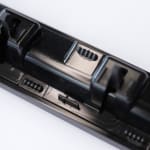
Rinco Ultrasonics, a leading global manufacturer of ultrasonic welding equipment, has demonstrated that servo-driven ultrasonic welding systems deliver significant energy savings versus standard pneumatic systems. In a recent commercial application with a leading European automotive manufacturer, Rinco showed that its eMotion 20kHz servo-driven ultrasonic welder provides an 87% energy savings over pneumatic systems for production of an automotive assembly.
Rinco’s work is believed to be the first effort to quantify the energy benefits of servo-driven ultrasonic welders. Many of the benefits of ultrasonic welding technology, such as fast cycle times, low cost of investment, repeatability, and a high level of process control are common knowledge in the industry. However, recent drive technology advancements have brought breakthroughs in the capabilities of the process and even significantly reduced the energy consumed, according to Rinco.
"We expected the electrically driven ultrasonic welding machine to perform better in terms of energy consumption, but we didn't expect such a big difference," said Jürgen Baumert, head of R&D at Rinco Ultrasonics. Servo-driven ultrasonic presses have become well known for a high level of control and precision. However, the reduced energy savings and finished part strength and aesthetic improvements are often not fully appreciated, the company says.
The automotive assembly required the use of ultrasonic assembly equipment to bond components of dissimilar materials (PA-12 to PC/ABS). Due to the material incompatibility, a true weld could not be achieved and a mechanical forming process had to be used to assemble the parts. Rinco’s Simon Hug, Head of the company’s Ultrasonic Competence Center in Romanshorn, Switzerland, conducted the study. He compared a servo-driven system and a pneumatic drive system utilizing high-cost compressed air. The resulting energy costs as well as bond performance were compared. To compare apples to apples in the test, Rinco compared two machines whose frequency, power, and stroke were identical, while only the drives differed.
The results of the study showed a faster cycle time, improved finished part strength, energy savings of 87%, as well as aesthetic improvements with the servo-driven system. Rinco also reports that the eMotion welder’s unique ability to manipulate the melt velocity enabled better and stronger bonds.
Rinco continues to examine the benefits resulting from servo motion control technology in the ultrasonic welding process. While servo drive technology is not the answer to every application in ultrasonics, it shows promise for customers focused on energy savings and assembly quality in plastic part assembly.




